How to Get Emoji Keyboard on Windows
Introduction
Emojis have become an essential part of digital communication, adding a fun and expressive element to text. Whether you're using social media, email, or professional applications, integrating emojis can help convey emotions and messages more effectively. If you're wondering how to get an emoji keyboard on Windows, this blog will guide you through the process. From built-in options to third-party applications, and customization tips, we've covered it all in detail to enhance your emoji experience on Windows.

Accessing the Built-In Emoji Keyboard on Windows
Windows provides a built-in emoji keyboard that is easily accessible through simple steps. This feature is available on both Windows 10 and Windows 11, but the process can slightly differ between the versions.
Using Keyboard Shortcuts
One of the quickest ways to access the built-in emoji keyboard is through a keyboard shortcut:
- Press the Windows key + Period (.) or the Windows key + Semicolon (;).
- The emoji keyboard will pop up immediately, allowing you to browse and insert your favorite emojis.
Accessing Through On-Screen Keyboard
For users who prefer not to use keyboard shortcuts, the on-screen keyboard provides an alternative:
- Right-click on the taskbar and select 'Show touch keyboard button.'
- A keyboard icon will appear on the taskbar. Click on it to open the on-screen keyboard.
- Click on the emoji icon to access the emoji keyboard.
Emoji Keyboard on Windows 10 vs. Windows 11
While both versions support the emoji keyboard, users on Windows 11 might experience a more refined and visually appealing interface. The selection of emojis might also be broader on Windows 11 compared to Windows 10, offering an improved user experience.
Using the Emoji Keyboard in Different Applications
Once you have access to the emoji keyboard, you can use it across various applications. Knowing how to use emojis in different programs can enhance your communication skills and add a playful touch to your texts.
Emojis in Microsoft Word and Excel
Adding emojis to your documents and spreadsheets in Microsoft Office applications is straightforward:
- Open Microsoft Word or Excel.
- Use the keyboard shortcut (Windows key + .) to open the emoji keyboard.
- Click on an emoji to insert it into your document or cell.
Using Emojis in Web Browsers
Emojis can also enhance your web browsing experience. For example, you can use them in search queries, emails, or social media sites:
- Open your preferred web browser.
- Click on a text field (e.g., search bar, email composition box).
- Use the keyboard shortcut (Windows key + .) to open the emoji keyboard.
- Select your desired emoji and insert it.
Emojis in Messaging and Social Media Apps
Emojis are an excellent way to express emotions in messaging apps and social media platforms. Here's how you can do it:
- Open your desired messaging or social media app (e.g., WhatsApp, Facebook, Twitter).
- Tap on the text input field.
- Press the keyboard shortcut (Windows key + .) to open the emoji keyboard.
- Choose your favorite emoji and send it.

Customizing Your Emoji Experience
Beyond the built-in emoji keyboard, you can further enrich your experience by adding new emojis, creating custom shortcuts, and exploring emoji packs and extensions.
Adding New Emojis
To add new emojis, you can use various online resources that allow you to download and install emoji packs. Available sites offer a wide range of emojis that can be integrated into your system:
- Download the desired emoji pack from a trusted source.
- Follow the installation instructions provided with the pack.
- Once installed, these emojis should become available in your built-in emoji keyboard.
Creating Custom Emoji Shortcuts
Creating custom shortcuts for frequently used emojis can save time:
- Open the emoji keyboard (Windows key + .).
- Select an emoji, then right-click on it.
- Choose the option to create a custom shortcut and set your desired key combination.
Exploring Emoji Packs and Extensions
Several browser extensions and apps offer expanded emoji packs and unique features:
- Search for emoji extensions in your browser's extension store.
- Install the extension and follow the setup guide.
- Access a broader range of emojis directly from your browser.
Installing Third-Party Emoji Keyboard Applications
Apart from the built-in options, third-party emoji keyboard applications provide additional functionalities and customization.
Top Recommended Apps
Popular third-party apps include:
- Emoji Panel: Offers an extensive range of emojis.
- WinMoji: Integrates seamlessly with Windows OS.
- Cool Symbols Emoji Emoticon: Provides various symbols and emoticons.
Installation Process
Installing third-party apps is usually straightforward:
- Download the app from a trusted source.
- Follow the installation instructions provided.
- Launch the application and explore its features.
Pros and Cons of Third-Party Apps
While third-party apps offer added benefits, they also come with potential drawbacks:
Pros: - Wider range of emojis and symbols. - Customization options. - Enhanced user interface.
Cons: - May consume additional system resources. - Potential security risks if downloaded from untrusted sources. - Might require periodic updates.

Troubleshooting Common Issues
Sometimes, you may encounter issues with the emoji keyboard. Here’s how to troubleshoot common problems effectively.
Emoji Keyboard Not Opening
If your emoji keyboard is not opening, try these steps:
- Ensure your system is up to date.
- Restart your computer.
- Check if the keyboard shortcut is correctly configured.
Emojis Not Displaying Correctly
When emojis don't display correctly:
- Make sure you have the latest graphics drivers installed.
- Verify that your application supports emojis.
- Reinstall the emoji keyboard if necessary.
System Compatibility and Updates
Compatibility issues can sometimes affect the emoji keyboard functionality:
- Ensure your Windows version supports the emoji keyboard.
- Keep your system updated with the latest Windows updates.
- Consult the official Microsoft support page for more guidance.
Conclusion
Incorporating emojis into your digital communication on Windows is simple and enhances expression. Whether you use the built-in emoji keyboard, opt for third-party applications, or customize your emoji experience, the tools are readily available to suit your needs. Troubleshooting tips ensure you can solve common issues efficiently, keeping your emoji use seamless and fun. Dive into the colorful world of emojis and make your texts vibrant!
Frequently Asked Questions
How do I add more emojis to my Windows keyboard?
To add more emojis, download emoji packs from trusted sources and install them following the provided instructions.
Can I use custom emojis on Windows?
Yes, you can create custom emoji shortcuts and use third-party apps to add custom emojis to your Windows keyboard.
What should I do if the emoji keyboard stops working?
If the emoji keyboard stops working, ensure your system is up to date, restart your computer, and check the keyboard shortcut configuration.



